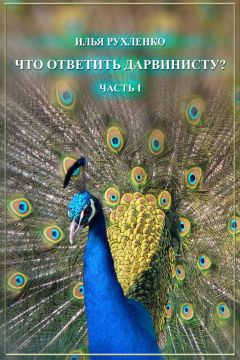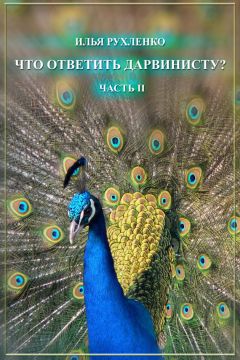Предложите Вашему верующему дарвинисту самому выбрать тот вариант, который ему больше нравится.
Понятно, что я сейчас озвучиваю совершенно антидарвиновские вещи. Во-первых, потому что «покусился» на самое святое – на идею изменяемости видов. А во-вторых, потому что свободно рассуждаю о наличии у биологических видов таких признаков, которые биологически не целесообразны. Для дарвинизма биологическая целесообразность строго обязательна – признак должен приносить пользу, или хотя бы не мешать.
А вот в рамках других концепций, биологически не целесообразные признаки у организмов вполне могут существовать. Например, в русле концепции разумного дизайна, некоторая часть биологической целесообразности вполне может быть принесена в жертву ради каких-то других целей. Например, в пользу чисто эстетической целесообразности. То есть, бабочка может быть красиво окрашена именно потому, чтобы быть красиво окрашенной. И никаких других (скрытых) биологически целесообразных причин красивой окраски у этой бабочки просто не имеется.
Кроме того, организмы могут иметь какие-то признаки не только ради эстетики, но и просто ради разнообразия. Например, те же пяденицы, совки или какие-нибудь моли далеко не все выглядят «писаными красавицами». Но вот в однообразии эти семейства бабочек точно не упрекнёшь. Впрочем, как и весь отряд бабочек в целом, и уж тем более, класс насекомых вообще.
Ahn D., Ho R.K. Tri-phasic expression of posterior Hox genes during development of pectoral fins in zebrafish: implications for the evolution of vertebrate paired appendages // Dev Biol. 2008. V. 322. № 1. P. 220–233.
Allen G.R., Midgley S.H., Allen M. Field Guide to the Freshwater Fishes of Australia. Eds. Jan Knight/Wendy Bulgin. Perth, W.A.: Western Australia Museum, 2002. P. 54–55.
Atluri J.B., Samatha B., Bhupathi Rayalu M. Life history, phenology, host plant selection and utilization in the endangered danaid eggfly Hypolimnas misippus // Int. J. Adv. Res. Technol. 2013. V. 2. № 3. P. 117–126.
Bagatharia S.B., Joshi M.N., Pandya R.V., Pandit A.S., Patel R.P., Desai S.M., Sharma A., Panchal O., Jasmani F.P., Saxena A.K. Complete mitogenome of asiatic lion resolves phylogenetic status within Panthera // BMC Genomics. 2013. V. 14. P. 572.
Bejan A., Charles J.D., Lorente S. The evolution of airplanes // J. Appl. Phys. 2014. V. 116. № 4. id.044901; doi: 10.1063/1.4886855
Betancur-R. et al. The Tree of Life and a New Classification of Bony Fishes // PLOS Currents Tree of Life. 2013. Edition 1. doi: 10.1371/currents.tol.53ba26640df0ccaee75bb165c8c26288.
Bininda-Emonds Olaf R.P. et al. The delayed rise of present-day mammals // Nature. 2007. V. 446. P. 507–512.
Bischoff R.J., Gould J.L., Rubenstein D.I. Tail size and female choice in the guppy (Poecilia reticulata) // Behavioral Ecology and Sociobiology. 1985. V. 17. P. 253–255.
Bishop J.A. An experimental study of the cline of industrial melanism in Biston (L.) (Lepidoptera) between urban Liverpool and rural North Wales // J Anim Ecol. 1972. V. 41. P. 209–243.
Bishop J.A., Cook L.M., Muggleton J. (a) The response of two species of moths to industrialization in northwest England. I. Polymorphism for melanism // Philos Trans R Soc Lond B Biol Sci. 1978. V. 281. P. 489–515.
Bishop J.A., Cook L.M., Muggleton J. (b) The response of two species of moths to industrialization in northwest England. II. Relative fitness of morphs and population size // Philos Trans R Soc Lond B Biol Sci. 1978. V. 281. P. 517–542.
Blut C., Wilbrandt J., Fels D., Girgel E.I., Lunau K. The «sparkle» in fake eyes – the protective effect of mimic eyespots in lepidoptera // Entomol Exp Appl. 2012. V. 143. P. 231–244.
Bolhuis J.J., Okanoya K., Scharff C. Twitter evolution: converging mechanisms in birdsong and human speech // Nat. Rev. Neurosci. 2010. V. 11. P. 747–759.
Brakefield P.M. A decline of melanism in the peppered moth, Biston betularia in the Netherlands // Biol J Linn Soc Lond. 1990. V. 39. P. 327–334.
Brakefield P.M., Liebert T.G. Evolutionary dynamics of declining melanism in the peppered moth in the Netherlands // Proc R Soc Lond B Biol Sci. 2000. V. 267. P. 1953–1957.
Breuker C.J., Brakefield P.M. Female choice depends on size but not symmetry of dorsal eyespots in the buttefly Bicyclus anynana // Proc. Biol. Sci. 2002. V. 269. № 1497. Р. 1233–1239.
Brilot B.O., Normandale C.L., Parkin A., Bateson M. Can we use starlings’ aversion to eyespots as the basis for a novel ‘cognitive bias’ task? // Applied Animal Behaviour Science. 2009. V. 118. P. 182–190.
Brower L.P. Chemical defence in butterflies. / In: The Biology of Butterflies. Ed. by Vane-Wright R.I., Ackery P.R. Academic Press, London, 1984. P. 109–134.
Buck M., Marshall S.A., Cheung D.K.B. Inentification atlas of the Vespidae (Hymenoptera, Aculeata) of the northeastern Nearctic region // Canadian Journal of Arthropod Identification. № 5. P. 1 – 492.
Calkins J.D., Burley N.T. Mate choice for multiple ornaments in the California quail, Callipepla californica // Animal behaviour. 2003. V. 65. P. 69–81.
Carde R.T. Precopulatory Sexual Behavior of the adult gypsy moth / In: The gypsy moth: research toward integrated pest management. Ed. by Doane C.C., McManus M.L. Technical Bulletin 1584, Forest Service, US Department of Agriculture, Washington, 1981. P. 572–587.
Chen A.H., Lubkowicz D., Yeong V., Chang R.L., Silver P.A. Transplantability of a circadian clock to a noncircadian organism // Science Advance. 2015. V. 1. № 5. P. e1500358.
Charnov E.L., Schaffer W.M. Life history consequences of natural selection: Cole’s result revisited // American Naturalist. 1973. V. 107. P. 791–793.
Clarke C.A., Mani G.S., Wynne G. Evolution in reverse: clean air and the peppered moth // Biol J Linn Soc Lond. 1985. V. 26. P. 189–199.
Cole L.C. The population consequences of life history phenomena // The Quarterly Review of Biology. 1954. V. 29. P. 103–137.
Cook L.M. Changing views on melanic moths // J Linn Soc. 2000. V. 69. P. 431–441.
Cook L.M. The rise and fall of the carbonaria form of the peppered moth // Q Rev Biol. 2003. V. 78. P. 399–417.
Cook L.M., Askew R.R., Bishop J.A. Increasing frequency of the typical form of the peppered moth in Manchester // Nature. 1970. V. 227. P. 1155.
Cook L.M., Grant B.S., Saccheri I.J., Mallet J. Selective bird predation on the peppered moth: the last experiment of Michael Majerus // Biol. Lett. 2012. V. 8. P. 609–612.
Coyne J.A. Not black and white // Nature. 1998. V. 396. P. 35–36.
Cuevas J.M., Elena S.F., Moya A. Molecular basis of adaptive convergence in experimental polulations of RNA viruses // Genetics. 2002. V. 162. № 2. P. 533–542.
Czerkas S., Feduccia A. Jurassic archosaur is a non-dinosaurian bird // Journal of Ornithology. 2014. V. 155. № 4. P. 841–851.
Dakin R., Montgomerie R. Peahens prefer peacocks displaying more eyespots, but rarely // Animal Behaviour. 2011. V. 82. № 1. P. 21–28.
DasGupta S., Ferreira C.H., Miesenböck G. FoxP influences the speed and accuracy of a perceptual decision in Drosophila // Science. 2014. V. 344. P. 901–904.
Davalos L.M., Girranello A.L., Geisler J.H., Simmons N.B. Understanding phylogenetic incongruence: lessons from phyllostomid bats // Biol. Rev. 2012. V. 87. P. 991–1024.
Davis M.C., Dahn R.D., Shubin N.H. An autopodial-like pattern of Hox expression in the fins of a basal actinopterygian fish // Nature. 2007. V. 447. P. 473–476.
Davis B.W., Li G., Murphy W.J. Supermatrix and species tree methods resolve phylogenetic relationships within the big cats, Panthera (Carnivora: Felidae) // Mol Phylogenet Evol. 2010. V. 56. № 1. P. 64–76.
Dawkins R. The Greatest Show on Earth: The Evidence for Evolution. Free Press, New York, 2009. 470 p.
De Jong W.W. Molecules remodel the mammalian tree // Trends Ecol Evol. 1998. V. 13. № 7. P. 270–275.
Dugatkin L.A. Interface between culturally based preferences and genetic preferences: Female mate choice in Poecilia reticulata // Proc. Natl. Acad. Sci. USA. 1996. V. 93. P. 2770–2773.
Dugatkin L.A. Sexual selection and imitation: females copy the mate choice of others. // Am. Nat. 1992. V. 139. P. 1384–1389.
Eakley A.L., Houde A.E. Possible role of female discrimination against «redundant» males in the evolution of colour pattern polymorphism in guppies // Proc. Biol. Sci. 2004. V. 271. P. S299-S301.
Endler J.A., Houde A.E. Geographic variation in female preferences for male traits in Poecilia reticulata. // Evolution. 1995. V. 49. P. 456–468.
Endler J.A. Natural selection on color patterns in Poecilia reticulata // Evolution. 1980. V. 34. № 1. P. 76–91.
Evans J.P., Bisazza A., Pilastro A. Female mating preferences for colourful males in a population of guppies subject to high predation // Journal of Fish Biology. 2004. V. 65. P. 1154–1159.
Everett A., Tong X., Briscoe A.D., Monteiro A. Phenotypic plasticity in opsin expression in a butterfly compound eye complements sex role reversal // BMC Evolutionary Biology. 2012. V. 12. P. 232.
Exnerova A., Svadova K., Fousova P., Fucikova E., Jezova D., Niederlova A., Kopeckova M., Stys P. European birds and aposematic Heteroptera: review of comparative experiments // Bulletin of Insectology. 2008. V. 61. P. 163–165.
Exnerova A., Svadova K.H., Fucikova E., Drent P., Stys P. Personality matters: individual variation in reactions of naïve bird predators to aposematic prey // Proc. R. Soc. B. 2010. V. 277. P. 723–728.
Farr J.A. Male rarity or novelty, female choice behavior, and sexual selection in the guppy, Poecilia reticulata Peters (Pisces: Poeciliidae) // Evolution. 1977. V. 31. P. 162–168.
Fay J.G., Wychkoff G.J., Wu C.-I. Positive and negative selection on the human genom // Genetics. 2001. V. 158. P. 1227–1234.
Fischer K., Perlick J., Galetz T. Residual reproductive value and male mating success: older males do better // Proc. R. Soc. B. 2008. V. 275. P. 1517–1524.
Forbush E.H., Fernald C.H. The gypsy moth. Wright and Potter Printing Co, Boston. 1896.
Fossat P., Bacque-Cazenave J., Deurwaerdere P.De, Delbecque J.-P., Cattaert D. Anxiety-like behavior in crayfish is controlled by serotonin // Science. 2014. V. 344. P. 1293–1295.
Freitas R., Gomez-Ckarmeta J.L., Rodriques P.N. New frontiers in the evolution of fin development // Journal of Experimental Zoology Part B: Molecular and Developmental Evolution. 2014. V. 322. № 7. P. 540–452.
Freitas R., Zhang G., Cohn M.J. Biphasic Hoxd gene expression in shark paired fins reveals an ancient origin of the distal limb domain // PLoS ONE. 2007; doi: 10.1371/journal.pone.0000754
Fuchs B., Wang W., Graspeuntner S., Li Y., Insua S., Herbst E.M., Dirksen P., Bohm A.M., Hemmrich G., Sommer F., Domazet-Loso T., Klostermeier U.C., Anton-Erxleben F., Rosenstiel P., Bosch T.C., Khalturin K. Regulation of polyp-to-jellyfish transition in Aurelia aurita // Curr. Biol. 2014. V. 24. P. 263–273.
Gladyshev E.A., Meselson M., Arkhipova I.R. Massive Horizontal Gene Transfer in Bdelloid Rotifers // Science. 2008. V. 320. P. 1210–1213.
Godin J-G.J, Briggs S.E. Female mate choice under predation risk in the guppy. // Anim. Behav. 1996. V. 51. P. 117–130.
Gong A., Gibson R.M. Reversal of a female preference after visual exposure to a predator in the guppy, Poecilia reticulate // Anim. Behav. 1996. V. 52. P. 1007–1015.
Gould S.J. Evolution's erratic pace // Natural History. 1977. V. 86. № 5. P. 14.
Gouramanis C., Webb, J.A., Warren A.A. Fluviodeltaic sedimentology and ichnology of part of the Silurian Grampians Group, western Victoria // Australian Journal of Earth Sciences. 2003. V. 50. P. 811–825.
Grant B.S. Fine tuning the peppered moth paradigm // Evolution. 1999. V. 53. P. 980–984.
Grant B.S., Owen D.F., Clarke C.A. Decline of melanic moths // Nature. 1995. V. 373. P. 565.
Grant B.S., Owen D.F., Clarke C.A. Parallel rise and fall of melanic peppered moths in America and Britain // J Hered. 1996. V. 87. P. 351–357.
Grantham R., Gautier C., Gouy M., Jacobzone M., Mercier R. Codon catalog usage is a genome strategy modulated for gene expressivity // Nucleic Acids Res. 1981. V. 9. P. r43–r74.
Grantham R., Gautier C., Gouy M., Mercier R., Pave A. Codon catalog usage and the genome hypothesis // Nucleic Acids Res. 1980. V. 8 № 1. P. r49-r62.
Grehan J.R., Schwartz J.H. Evolution of the second orangutan phylogeny and biogeography of hominid origins // Journal of Biogeography. 2009. V. 36. № 10. P. 1823–1844.




